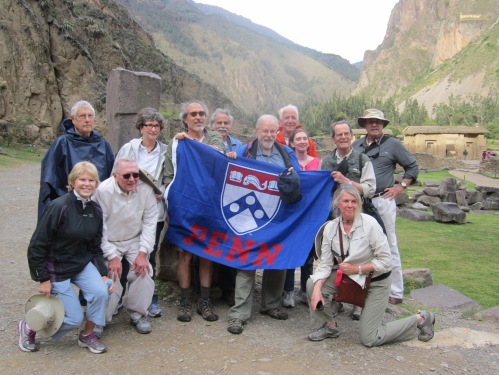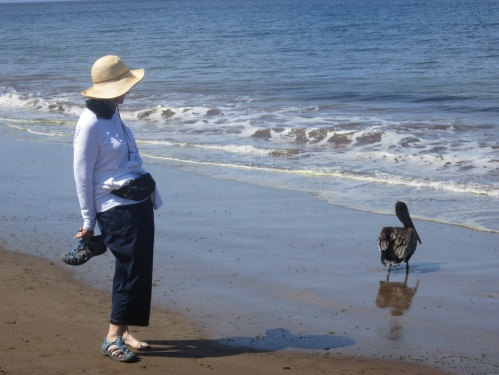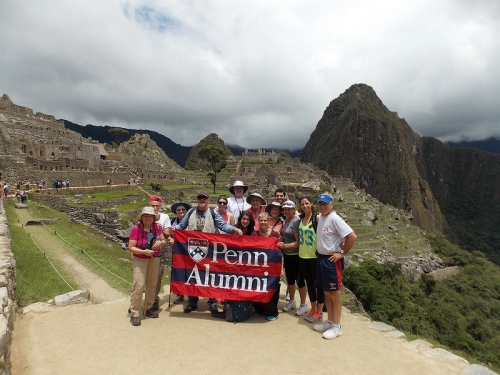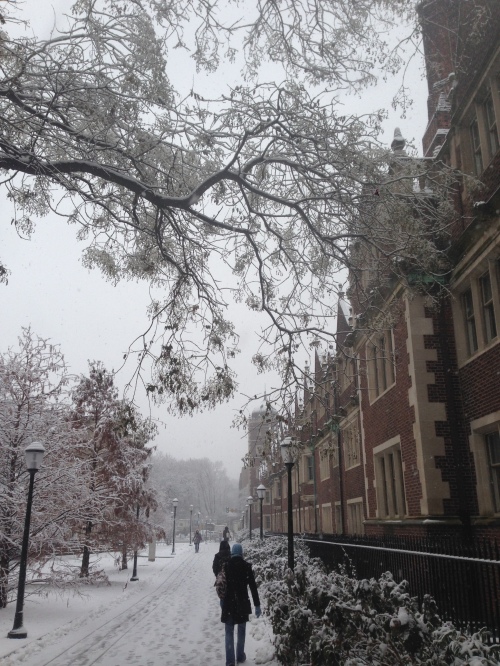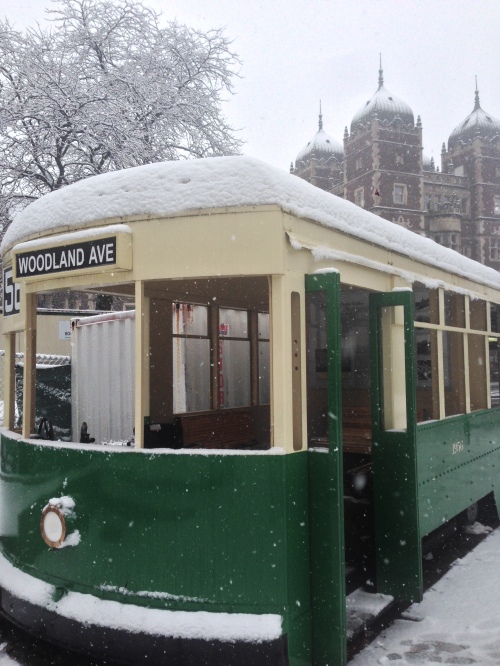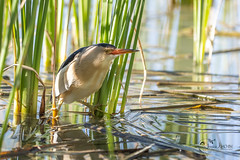Author: Professor Peter Dodson, Dept. of Earth and Environmental Sciences
This November 16-30, I led a Penn Alumni Travel trip with 14 Penn alumni and friends. Four of us went on a pre-trip excursion to the Amazon, leaving from Iquitos, northeastern Peru, the largest city in the world accessible neither by road or by rail. Here the highway is the mighty Amazon itself and its tributaries. We stayed at Ceiba Tops Ecological Lodge and reveled in the treasures of the rainforest–the colorful birds and insects, the inquisitive tapir, the riotous tropical plants. We also visited two indigenous villages, one of which still maintains its pre-colonial lifestyle.
Back to Lima, we met the full contingent of Alumni Travelers along with our Odyssey guide for Peru, Marco Ayala. Marco was friendly, knowledgeable and witty, a great companion who anticipated our every need and was on top of every situation. After a quiet morning we spent the afternoon exploring a bit of Lima, including early Spanish churches in the city center and a visit to the splendid Larco Museum of pre-Columbian art. This was our introduction to the pre-European history of Peru. The following morning was an early departure from the hotel for our one-hour flight to Cuzco in the Andes, the capital city of the Incas.
Here we met our local guide, Anna Marie, who is highly knowledgeable about all things Incan. As Cuzco is 11,000 feet above sea level, it is deemed wise to begin the visit in the Sacred Valley of the Incas, which is a mere 9,000 feet high. The beautiful Casa Andina served as our base for two days as we explored the Sacred Valley and saw many Incan walls and terraces. The Incas were master engineers and stone masons, and we witnessed their impact throughout the landscape.
We also viewed current agricultural practices as the land was being prepared for planting of corn, potatoes and other crops as the rainy season was soon to begin in December. We could see in plots side-by-side a field plowed by hand with a team of oxen and a field plowed by modern John Deere tractor. We visited a village where native women spun llama and alpaca fleece into wool, dyed it brilliant natural colors, then wrought the wool into beautiful native consumer goods. A highlight was a visit to the Incan fortress of Ollantaytambo on the Urubamba River.
The next day we took the train down the Sacred Valley as the Urubamba River dropped 2000 feet into tropical cloud forest to Aquas Calientes. Then we took the most breathtaking imaginable bus ride up through 13 switchbacks on shear side of the mountain to arrive at Machu Picchu Ecological Lodge, where we spent the night. This exquisite boutique hotel is the only guest accommodation on site. We had the privilege of tranquil time at the site without the press of crowds. We had two guided tours of the vast and stunning site, which is truly a city in the clouds — its shear cliffs remind me of a Yosemite in the tropics. The intrepid among us even participated in a rather taxing climb of Wayna Picchu, the smaller mountain that overlooks the back of the site.
Machu Picchu is everything that I had imagined and more. As Anna Marie made clear, the Incans showed every bit of the skill of the Egyptians in moving large blocks and fitting them together flawlessly without mortar. They also understood water perfectly. A significant overnight rain failed to make any impact on the site. Reluctantly we descended the mountain and took the train back to Cuzco. We stayed in a truly original hotel, El Monasterio, a Franciscan monastery whose construction began in 1595. The guest rooms were palatial and the hospitality exquisite — as close to five star as I am ever likely to experience.
My first talk took place in a gorgeous ornate high ceilinged chapel–and oh, sweet irony–it was my Darwin talk! Some think Darwin and Christianity are incompatible, but I know differently. After exploring Cuzco, we said good bye to Marco and flew on to Quito via Lima, and were greeted by our Odyssey guide for Ecuador, Roberto Peralta. Roberto too was excellent, helpful, solicitous, knowledgeable, cheerful, and proud of is country.
We flew on to the Galapagos via Guayaquil, Ecuador’s largest city. At Baltra Airport we were met by our local naturalist, the high-spirited Dora Ulloa. We rode by bus from the airport, ferried across a canal (where the air was alive with seabirds flying to and fro), and southward across Santa Cruz Island towards Puerto Ayora, the largest town in the Galapagos. In about 20 minutes we found ourselves in surprisingly lush vegetation at an altitude of about 2500 feet. Soon we were down at sea level again in Puerto Ayora. Here at the town dock we were met by two zodiac inflatable boats, locally called pangas, and whisked out to the Coral II, our beautiful 110 foot boat that was to be our home for the next three days.
We were met by the uniformed crew with the “Galapagos Greeting,” a firm forearm-to-forearm embrace that facilitates safe transfer from panga to ship or panga to shore. We settled into our staterooms, enjoyed a nice lunch, and then went ashore with Dora and Roberto to visit the tortoise breeding facility of the Darwin Research Center. Here we saw many Galapagos tortoises of varying sizes and shapes, many destined to be returned to their native islands. We also saw Darwin’s finches and mockingbirds moving about. Later we returned to the Coral II, enjoyed an excellent dinner and eventually repaired to our cabins.
The ship sailed during the night, and walking with a cup of coffee during breakfast was a challenging. Shortly later we anchored near a tranquil lagoon, and our first shore excursion was highly rewarding. We were greeted on the beach by welcoming sea lions, Sally Lightfoot crabs and land iguanas. Later we snorkeled in the lagoon, swimming over a white-tipped reef shark and a green sea turtle, and we observed shoals of colorful reef fishes. In the afternoon we landed on beautiful South Plaza Island, whose rocky shores were guarded by sea lions and whose air space was thick with sea birds, including boobies, petrels, shearwaters, gulls and pelicans.
The following day we toured a boobie and frigate bird rookery on North Seymour Island. In the afternoon we walked a sandy beach, saw a flamingo, and snorkeled along the reef off the beach. Finally we made a long crossing to San Cristobal, visited the Galapagos Interpretive Center, and regretfully returned to Quito. Good things still remained. We spent a day at Antisana Preserve along volcano alley where we viewed 19,000 foot snow-covered volcanic cones (Antisana, Cotopaxi) and majestic Andean condors from a distance.
Our final day involved historic churches in Quito, a trip to the Middle of the Earth — the Equator where we stood with one foot in the Southern Hemisphere and the other foot in the Northern Hemisphere. We ate lunch at the elegant and dramatic El Crater on the very rim of an ancient caldera with Ecuadorian cloud forest falling away beneath our feet.
And so it ended. What a splendid trip filled with natural and cultural wonders. Penn Alumni Travel is absolutely first class all the way. It is an absolutely worry-free way to travel and learn about other cultures and habitats. There is something for everyone everyday. It was thoroughly enjoyable and I recommend it wholeheartedly.
[To learn more about Penn Alumni Travel and our 2014 schedule, click here.]




























